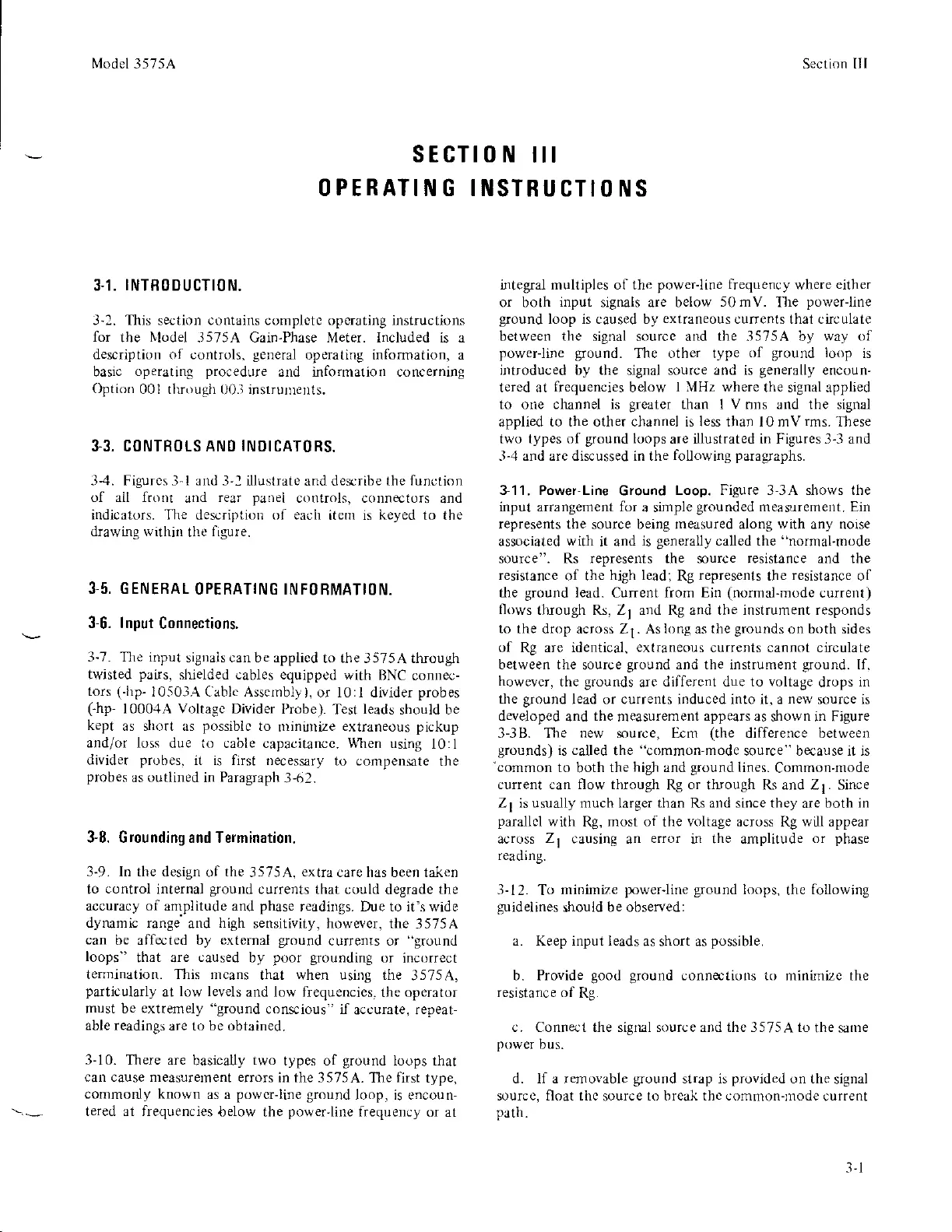Model 3575A
SECTI
PERATING
!
3.1.
INTBOD
UCTIO
N.
l-2. This section contains completc operating instructions
for
the
Nlodel
.1575A Gain"Phase Meter. Included is a
description of controls.
general
operating information, a
basic
operatins
procedure
ard information concerning
Optior)
001 thrrrueh
()Oi
instrunreDts.
3.3. CONTRO LS ANO
INDICATORS.
-3-,1.
Figurcs
-i-
I lnd
-l'l
illuslrate and describe
the Iunction
of all front
and
rear
panei
controls, connectors
and
indicators. The
dey:ription
()f
eacir
item is
keyed
to the
drawing within
the
figure.
3.5. GENEBAL
OPERATING INFORMATION.
3-6. lnput
Connections.
3-7. The input
si8nals can be applied
to the 3575A through
twisted
pairs,
shielded cables equipped
with BNC
connec-
tors (-hp-
l050iA
('ablc
Asscmbly
),
or 10:l divider
probes
(hp-
1000.1A Voltagc Divider
Probe).
Test
leads
should be
kept
as short as
possiblc
to
n)ininize
extraneous pickup
and/or loss
due to cable capacitancc. When using
l0:l
divider
prr.)bes.
it is first .ecesMrv
to compeuate
the
probes
as
outlined
in
Paragraph
3-62.
3'8. G
rou
nding and Termination.
3"9.
ln the design
of
the
3575A,
extra
care has been talen
to
control
internal
gound
currents that could
degrade
the
accuracy of anplitude and
phase
readilgs. Due to it's wide
dynamic range
and
high
sensitivity, however, the
3575A
can
be affocted by
external ground
currents or
"ground
loops"
that are
caused
by
poor grounding
or
incorrect
tennination. This nrcans
that when usirg the.l575A,
particularly
at
low levels
and low frequencies.
the operator
must be extremely
"ground conscious
'
if
accurate. repeat-
able readings
are to be obtained.
3-10.
There are
basically
two
types of
ground
loops that
can cause measurernent errors
in the 3575A.
The
flrst
type,
commonly knorvn
as a
powcr-line ground
loop, is encoun-
tered at frequencies
trelow
the
power,line
frequency
or at
Section UI
0N
ilt
NSTRUCTIO
NS
integral multiples of the
poweriine frequency
where
either
or both
input
signals are below
50mV.
Il1e
power-line
ground
loop is caused by
extraneous
curents that ci0ulate
between
the
signal source and the 3575A by
way of
power-line ground.
The other type
of
ground
loop
is
introduced by the
signal source
and is
generally
encoun'
tered at
frequencies
below
I MIJZ where
the signal 3pptied
to one channel is
greater
than
I
V nns
and
the signal
applied to the other channel is less than l0 mV
rms.
These
two
types of
ground
loops
are illustrated in Figures 3--l and
-l-4
and arc discussed in the
following
paragraphs.
311. Power'Line
Ground
Loop. Figure 3-3A shows the
hput arrangement for
a simple
grounded
measurement. Ein
represents
the source being measured along with any noise
associated
with
it and
is
generally
called the
"nornal"mode
source". Rs represents the source resistance and the
resistance of
the
high leadl
Rg
represents
the
resistance
of
the
ground
lead.
Current
from Ein
(normal-mode
current)
flows
tluough Rs, Z; ald Rg and the instrument responds
to
the drop across 21. As
long
as
the
grounds
on both sides
of
Rg are identical,
extraneous
currents cannot ciculate
between the
source
ground
and the instrument
ggound.
If.
howevcr.
the
grounds
are
differcnt due to voltage
drops
in
the ground
lead or currents induced into it. a
new
source is
developed
and
the
measurement
appears
as shown in Figure
3-38. The
new
source, Ecm
(the
dilference between
grounds)
is called
the "common-mode source" be.cause it is
'comflron
to
both
the
high
and
ground
iines.
Common'mode
current can flow through
Rg
or
through fu and 21. Since
Zl is usually much larger than
Rs
and since they
are
both in
parallcl
with
Rg,
most of
the
voltage
across Rg
will
appear
acrr.rss
Z1
causing an
error
in the amplitude
or
phase
reading.
3-12.
To
mininTe
power-line
ground
loops.
the
following
guidelines
rhould
be observed:
a. Keep input leads
as short as
possible.
b. Provide
good ground
connections to minimizc the
resistance of
Rg.
c. Connect the sigrul source and the 3575A to
the same
power
bus.
d. lf a removable
ground
strap is
provided
on the
signal
source, float thc
source
to brcak thc comnlonrnode
current
p3th.
0
-3,1

